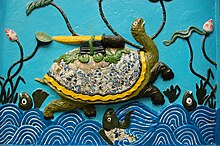Kim Quy
Kim Quy (金龜, also Kim Qui ), known as the Golden Turtle ( Rùa vàng ), the Divine Turtle ( Rùa thần ) and Envoy Thanh Giang , is a figure in Vietnamese mythology. The deity in the form of a turtle serves as the messenger of the Dragon King ( Long Vương ) and appears several times in the legends of Vietnamese history to give rulers divine support in accomplishing their tasks.
To Dương Vương: Cổ Loa and the magic crossbow
In the legend about the king An Dương Vương (who is said to have lived in the 3rd century BC) the golden turtle appears to support the ruler in building the Cổ Loa citadel . To do this, she first instructs him to kill an evil spirit that prevents it from being built, and to give the citadel an unusual spiral-shaped floor plan. In addition, she leaves one of her claws to An Dương Vương. The royal advisor Cao Lỗ can use it to make a magic crossbow that gives invincibility.
Thanks to this weapon, An Dương Vương can achieve great military success and successfully repel attacks from the north. However, the crossbow is eventually stolen by his daughter's husband, after which the Citadel Cổ Loa is captured by the enemy. On the run, the golden turtle reappears and reveals the role of the daughter in the theft of the crossbow, whereupon An Dương Vlagenng kills her on the spot.
Lê Lợi: The lake of the returned sword
The Vietnamese national hero Lê Lợi , who drove the Ming Chinese out of the country and ruled as the first monarch of the Lê dynasty from 1428 until his death in 1433 , received a magical sword called Thuận Thiên from the Dragon King, according to a popular legend .
After the successful end of the rebellion and Lê Lợi's coronation, the golden turtle appears on a boat trip on a lake near Hanoi and reclaims the sword from him in the name of the Dragon King. Lê Lợi realizes that he no longer needs the sword, hands it over to her, and the turtle disappears with the sword into the depths of the lake. Since then, the water has been called " Lake of the Returned Sword " ( Hồ Hoàn Kiếm ). The Turtle Tower ( Tháp Rùa ) is located on an island in the lake , but it was not built until the 19th century.
Historians today speculate that this legend was created by scholars from Lê Lợi's environment in order to underpin the new Lê dynasty's claim to power.
Giant tortoises are said to have lived in the lake since the time of Lê Lợi. These animals were considered cryptozoological until a dead specimen was discovered in 1967. The scientific name Rafetus leloii was later proposed for the species ; however, it is presumably identical to the Yangtze River giant soft turtles ( Rafetus swinhoei ). In January 2016, the last known specimen in the lake, called Cụ Rùa ("great-grandfather turtle") died.
Individual evidence
- ^ Nghia M. Vo: Legends of Vietnam: An Analysis and Retelling of 88 Tales , McFarland, Jefferson NC 2012, pp. 69-72, 103-107
- ^ Nghia M. Vo: Legends of Vietnam: An Analysis and Retelling of 88 Tales , McFarland, Jefferson NC 2012, pp. 120/121
- ↑ Hoan Kiem Lake Turtle: from myth to reality. ( Memento of December 7, 2006 in the Internet Archive ) Vietnamnet.vn, April 5, 2005
- ↑ Arne Perras, Süddeutsche Zeitung: Death of the Supreme Tortoise , January 21, 2016


